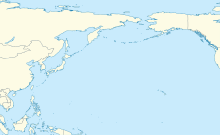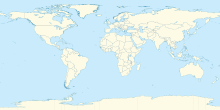|
Pohang Gyeongju Airport
Pohang Gyeongju Airport (IATA: KPO, ICAO: RKTH) is an airport in Pohang, North Gyeongsang Province, South Korea. In 2011, 255,227 passengers used the airport.[1] HistoryPohang Airfield was originally developed during the Japanese Imperial period. MilitaryPre-Korean war In early July 1950 Pohang airfield was identified as a potential base for USAF operations. On 7 July, Brigadier-General Timberlake deputy-commander of the Fifth Air Force ordered the development of the base. Company A 802nd Engineer Aviation Battalion landed at Pohang and began improving the airfield on 12 July by added a 500 feet (150 m) PSP extension and building hardstands for 27 F-51 Mustangs.[2] The airfield was designated by the USAF as K-3. Troops of the Korean People's Army (KPA) 12th Division infiltrated the Pohang area in early August and made guerrilla attacks against the airfield. By 12 August KPA troops entered Pohang and so on 13 August the 35th Fighter-Interceptor Group evacuated to Tsuiki Air Field in Japan. ROK and U.S. forces routed the KPA several days later, but the continued presence of guerrilla units mitigated against an early return to the base.[2]: 124 USAF units based there from July–August 1950 included:
The 802nd Battalion returned to Pohang on 27 September finding the airfield relatively undamaged. The 35th Fighter-Interceptor Group returned to Pohang on 3 October. On 12 October No. 77 Squadron RAAF operating F-51s arrived at Pohang.[2]: 178 In July 1953 the United States Navy deployed two AJ (A-2) Savage aircraft to K-3 as a nuclear deterrent in the final days of the Korean War.[3] Post-Korean WarIn October 2008 the United States Navy relocated a permanent detachment of MH-53E Sea Dragons assigned to HM-14 from Iwakuni, Japan. This detachment provides Seventh Fleet with a forward-deployed AMCM and heavy-lift asset. Because Pohang Gyeongju Airport is sharing with military, taking photograph or video of apron, runway and military facility is strictly prohibited. Civil operationin the 1970, Pohang Airfield developed capacity for civil operations. [4] Civil operations begain in 1986 with a route from Seoul route operated by Korean Air. [4] In the 1990s, Asiana Airlines started flights to Pohang Airport, its passenger terminal was expanded, and a new terminal was opened in June 2002. [4] On 15 March 1999, Pohang Airport was the destination of Korean Air Flight 1533, a McDonnell Douglas MD-83 which was flying from Seoul to Pohang. The flight overshot the runway during landing at Pohang Airport. All 156 people on board survived, but the aircraft was destroyed. The accident was the 11th hull loss of a McDonnell Douglas MD-80. [1] In January 2014, Pohang Airport was closed due to its runway having to be repaved.[5] This was completed in May 2016. [6] In 2020, Pohang and Gyeongju cities submitted a proposal to change the name of the airport from Pohang Airport to Pohang Gyeongju Airport to the Ministry of Land, Infrastructure and Transport. [7] In 2022, government approval for the request was granted and the airport received its current name, Pohang Gyeongju Airport.[8] Airlines and destinations
Statistics
Annual passenger traffic at KPO airport.
See Wikidata query.
AccessBus
References
External links |
||||||||||||||||||||||||||||||||||||||||||||||||||||||||||||||||||||||||||||||||||||||||||||||||||||||||||||||||||||||||||||||||||||||||||||||||||||||||||||||||||||||||||||||||||||





